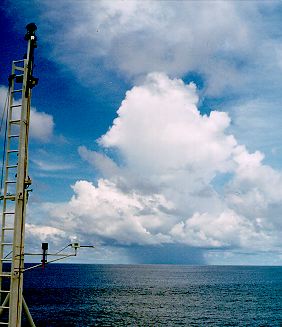 Convection in the atmosphere, observed through cloud formation and rain development in the equatorial Indian Ocean.
Convection in the atmosphere, observed through cloud formation and rain development in the equatorial Indian Ocean.In the atmosphere convection is driven by the ocean or the land surface, which receive heat from the sun during the day and in return heat the air from below. This lowers the air density near the ground and forces the air to rise.
When a convection cell develops, the air rises in a region of about 10 kilometres. Cooling of the rising air causes condensation, so the vertical extent of the convection cell becomes visible as a tall cumulonimbus cloud. Sinking of air occurs around the cloud, so the outer region of the convection cell remains cloud free.
As the air rises higher and higher (to 10 km height or more) the condensation turns into rain, which falls out as a heavy downpour from the centre of the convection cell.
Convective rain accounts for most of the rainfall in the tropics. It is very intense when it falls but very patchy in space and not long lasting in time.
contact address: